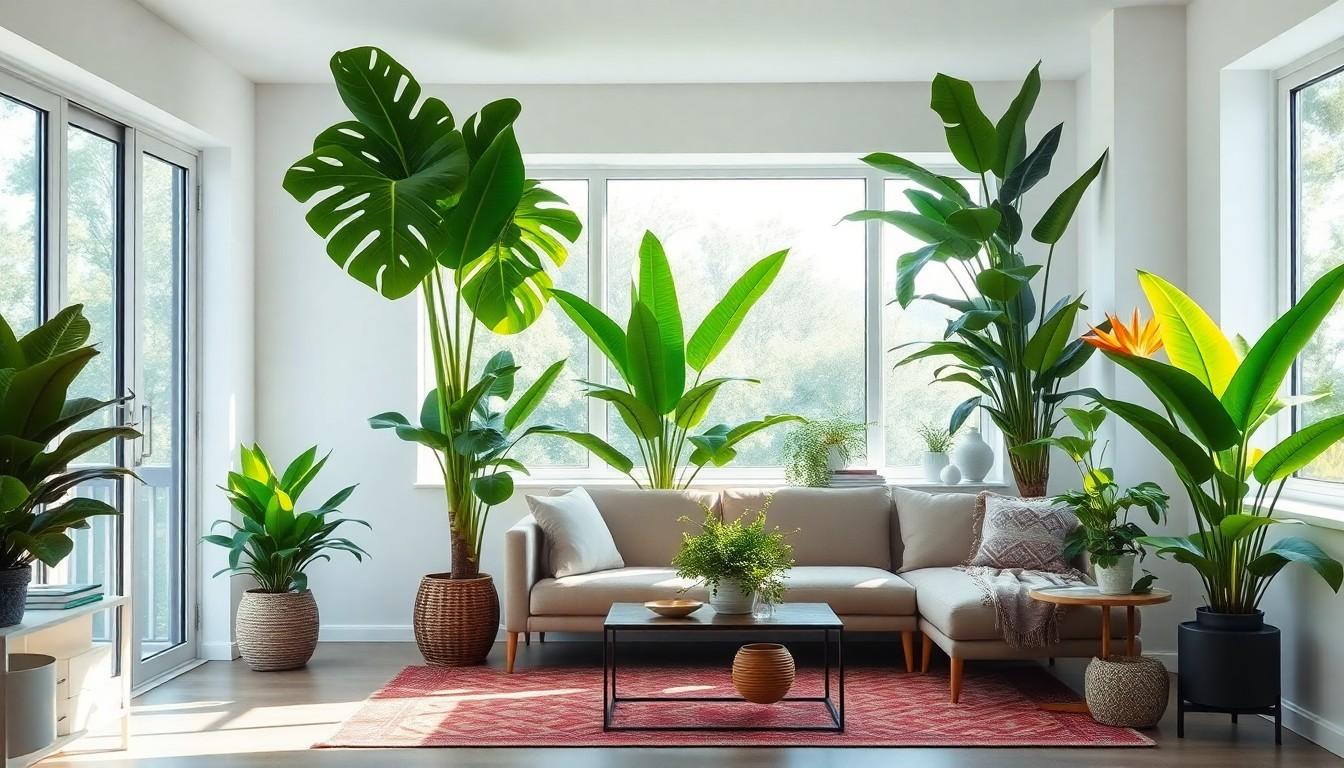Looking to elevate your indoor space? Tall indoor house plants might just be the secret weapon you need. Imagine transforming that dull corner into a lush paradise with a towering green friend that not only purifies the air but also gives your home a dose of personality. Who knew that a plant could be the life of the party?
Overview of Tall Indoor House Plants
Tall indoor house plants deliver striking visuals and offer numerous benefits. They fill vertical space, transforming empty corners into eye-catching focal points. These plants also contribute to a more inviting atmosphere, enhancing the overall aesthetic of a room.
Various species thrive indoors, with popular choices including the Fiddle Leaf Fig, Bird of Paradise, and Rubber Plant. Each type has unique characteristics, allowing homeowners to select options that align with their interior design.
Maintenance requirements vary among tall plants. Some species prefer bright, indirect light while others adapt well to lower light levels. Regular watering and occasional fertilization keep the plants healthy. Understanding each species’ needs ensures longevity and vibrancy.
Air purification plays a significant role in the appeal of tall indoor plants. They absorb toxins and improve indoor air quality, creating a healthier living environment. Studies show that plants like the Snake Plant and Spathiphyllum are particularly effective at filtering harmful chemicals.
Decorating with tall indoor plants encourages creativity. Grouping multiple plants together or placing them in unique pots adds interest. Consider varying heights and textures for a dynamic arrangement.
Selecting the right tall plants depends on the available space and personal style preferences. Some individuals prefer dramatic statements, while others opt for subtle additions. Regardless of the choice, incorporating tall indoor house plants enhances any living area, bringing life and energy indoors.
Benefits of Tall Indoor House Plants

Tall indoor house plants offer numerous advantages for any living space. They enhance aesthetics and contribute significantly to air quality.
Aesthetic Appeal
Transforming dull corners into vibrant areas, tall indoor plants provide striking visual interest. Incorporating species like the Fiddle Leaf Fig or Bird of Paradise creates bold focal points in the home. Height varies among plants, allowing for dynamic arrangements that capture attention. Unique leaf textures and shapes also contribute to diverse design themes. Arrangements can change rooms dramatically, making them feel lively and inviting. Personal style influences the selection of plants, enabling individuals to tailor their living spaces effectively.
Air Quality Improvement
Improving indoor air quality represents another significant advantage of tall indoor house plants. These plants absorb toxins and release oxygen, creating a healthier environment. Studies demonstrate the effectiveness of species such as the Rubber Plant in purifying air. Regular presence of plants has shown to reduce pollutants significantly. Clean air promotes better health, improving overall well-being. Integrating plants into interior spaces also supports psychological benefits, reducing stress levels and enhancing mood through improved air quality.
Popular Types of Tall Indoor House Plants
Many homeowners appreciate the presence of tall indoor house plants for their aesthetic appeal and air quality improvements. Here are some popular varieties to consider.
Fiddle Leaf Fig
Fiddle Leaf Figs stand out with their large, glossy leaves that provide a bold statement in any room. This plant thrives in bright, indirect light, making it ideal for well-lit spaces. Regular watering helps maintain its health, as it prefers moisture but does not tolerate overwatering. An interesting fact is that it can grow up to six feet tall indoors, allowing it to fill empty corners with life. Placing it near a window enhances its growth potential. Its striking appearance makes this plant a favorite among interior designers.
Rubber Plant
Rubber Plants, known for their broad, dark green leaves, exhibit a unique ability to purify indoor air. Adapting well to a range of light conditions, they flourish in bright or moderate indirect light. Occasional watering keeps the soil slightly moist, supporting optimal growth. A Rubber Plant can reach heights of up to eight feet, adding vertical interest to your space. They’re also low maintenance, making them perfect for busy individuals. Incorporating this plant contributes to healthier living environments.
Snake Plant
Snake Plants, characterized by their upright, sword-like leaves, provide an elegant touch to various decors. Known for their resilience, these plants thrive on neglect and adapt to low light. Watering infrequently helps prevent root rot, highlighting their low-maintenance appeal. Mature plants can grow up to four feet tall, making them an excellent choice for adding height to empty areas. They also improve indoor air quality, absorbing toxins effectively. Choosing a Snake Plant means introducing a durable yet stylish element into your home.
Care Tips for Tall Indoor House Plants
Caring for tall indoor house plants ensures their vibrancy and health. Attention to detail enhances their longevity and beauty.
Light Requirements
Ideal light conditions vary among tall indoor house plants. Fiddle Leaf Figs thrive in bright, indirect light, which encourages healthy growth. Bird of Paradise prefers similar lighting but tolerates some direct sun, enhancing its striking foliage. Rubber Plants adapt to lower light levels, making them versatile for different spaces. Monitor each plant’s response to light to prevent leaf drop or yellowing. Ensuring proper light will lead to flourishing plants.
Watering Guidelines
Watering needs differ among plant types. It’s important to check the topsoil; when the top 1 to 2 inches feel dry, it’s time to water. Fiddle Leaf Figs benefit from consistent moisture but dislike soggy soil. Rubber Plants prefer slightly drier conditions and should dry out between waterings. Overwatering is a common mistake that can cause root rot. Establish a routine, adjusting based on seasonal changes, to keep plants healthy.
Soil and Fertilization
Selecting the right soil encourages growth. A well-draining potting mix works well for most tall indoor plants, promoting aeration and root health. Incorporating peat or perlite can enhance drainage properties. Fertilizing during the growing season strengthens plants; choose a balanced liquid fertilizer applied monthly. Watch for signs of nutrient deficiencies, such as pale leaves or stunted growth. Regular soil checks and fertilization will help maintain vigorous plants.
Conclusion
Tall indoor house plants are more than just decorative elements; they play a vital role in enhancing both aesthetics and air quality. By selecting the right species, individuals can transform their spaces into vibrant and inviting areas that promote well-being.
With various options available, from the stunning Fiddle Leaf Fig to the resilient Snake Plant, there’s a perfect fit for every home. Proper care ensures these plants thrive, providing lasting beauty and health benefits. Embracing tall indoor plants can lead to a more creative and refreshing living environment, making them a worthy investment for any plant lover.

